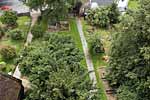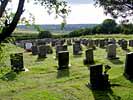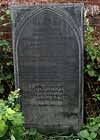Selston St HelenChurchyard
 Churchyard to the Churchyard to the
south of the church |
 Churchyard to the Churchyard to the
north of the church |
The original churchyard was the area immediately surrounding the church, which was formally closed to burials in 1857. It is roughly a quadrilateral in shape, with the church standing in the south-westerly quarter. The churchyard must have been extended in the second half of the 19th century, as the burial record is continuous, but the Diocesan Registers do not record any addition until 1893. It then records two further additions; 2 acres 2 roods 26 perches were added in 1924 and another section in 1931. The extensions of 1893 and 1924 were previously owned by the Butterley Company Ltd.
The boundaries of the churchyard are very varied. Across the south front of the church is stone wall, approximately 4ft (1.2m) high and 16 inches (40cm) thick, which includes a mounting block near the gate. Moving east the wall changes to brick at the point where Church Lane begins to change direction. Reaching the first house, the wall increases in height and turns away from the lane. Eventually it reaches a 90o bend, continuing as a brick wall along the northern edge of the churchyard. This wall ends at a brick pillar, one of a pair forming an entrance into the newest section of the churchyard, which lies north of the church. The graves in this very large area date from the 1940s to the present day, and there is still a large unused section. This area is fenced with concrete posts and wire, and a hedge runs along its northern edge. The whole of the western side of the churchyard has a hedge running along it.
The area of churchyard to the west of the church includes graves dating from the late nineteenth century to the 1930s. The grave of the Rev Charles Harrison can be seen here.
Near to the brick pillars which mark the entrance to the newest section can be seen three Commonwealth War Graves, one from 1917 and two from World War Two.
 Grave marker to Grave marker to
William Watersson
(died 1694) |
 Grave marker to Grave marker to
William Green (1877) |
The oldest headstones are in the original area of churchyard. Most of the headstones in this area were removed or laid flat to make paths in 1963, but a few remain in situ. Some are placed along the walls, including the headstone of a veteran of the Battle of Waterloo, who died in 1877. The oldest headstone is dated 1694, and there are some early 18th century headstones, including a table tomb from the 1750s near to the church porch. In all of the other areas of the churchyard the headstones remain standing.
Burial registers cover the years 1558 to the present day.
|